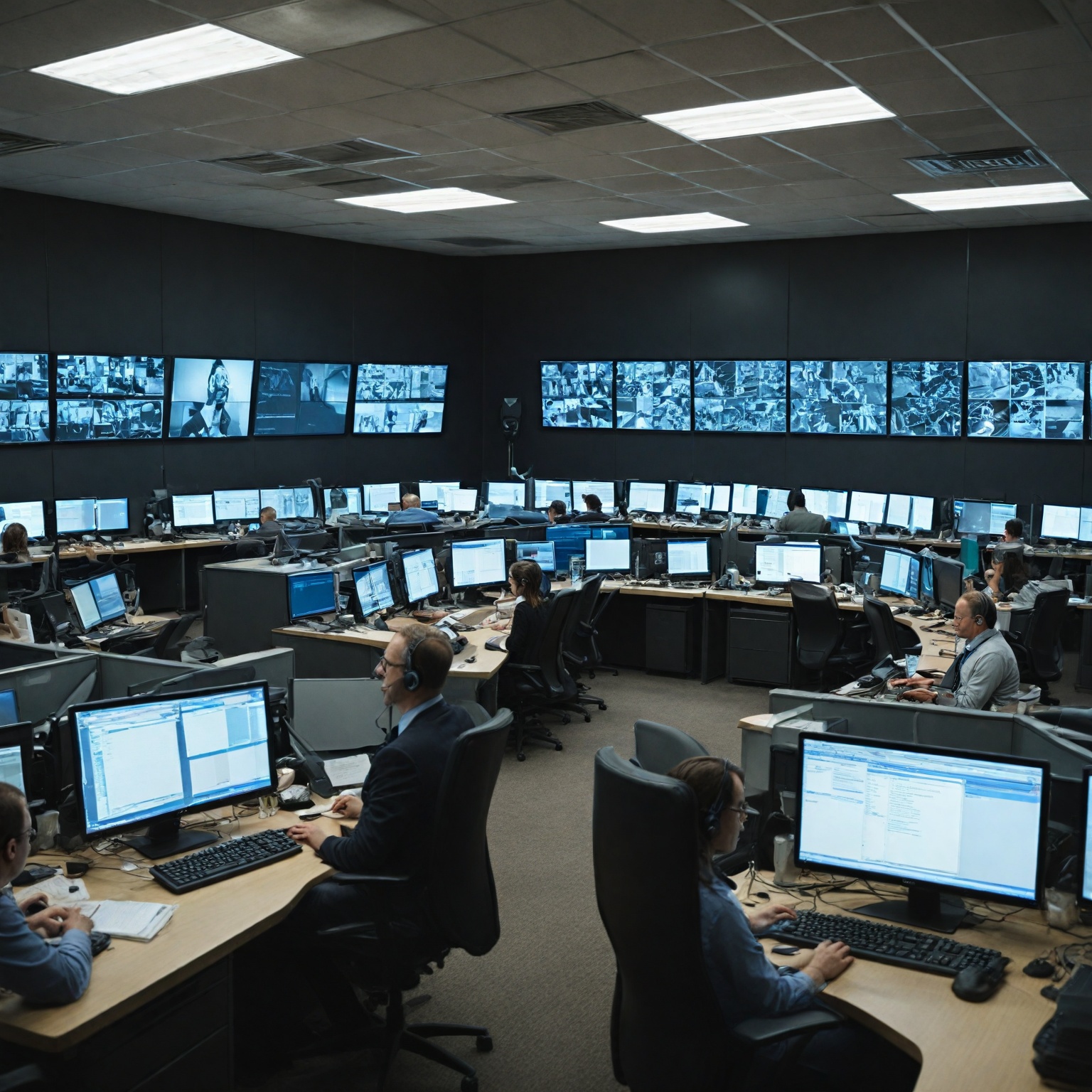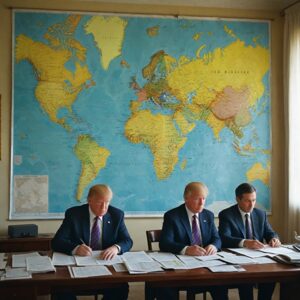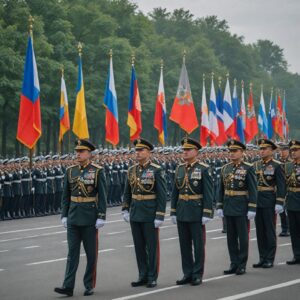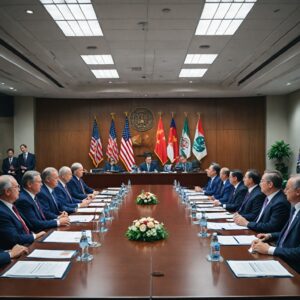Summary
Government surveillance involves the monitoring of individuals and groups by state agencies, often justified by national security and law enforcement objectives. This practice has expanded dramatically since the early 21st century, especially following the September 11, 2001 attacks, incorporating advanced technologies such as mass data collection, signals intelligence, and facial recognition systems. While intended to prevent threats like terrorism and crime, government surveillance programs have raised significant concerns over privacy rights, civil liberties, and potential abuses of power.
Privacy rights, enshrined in over 185 national constitutions and international human rights instruments, protect individuals from unwarranted intrusions into their personal and family lives by both government and private entities. The tension between surveillance imperatives and privacy protections is a defining issue of the digital age, intensified by revelations of mass surveillance programs and the deployment of intrusive technologies. Debates focus on how to reconcile collective security needs with respect for individual autonomy, especially as marginalized communities disproportionately bear the adverse impacts of surveillance.
Legally, government surveillance is governed by complex frameworks such as the Fourth Amendment in the United States, the Foreign Intelligence Surveillance Act (FISA), and international covenants like the International Covenant on Civil and Political Rights (ICCPR). Reforms like the USA Freedom Act have attempted to limit bulk data collection and enhance oversight, yet questions persist about transparency, judicial accountability, and the potential for surveillance overreach. Furthermore, emerging privacy-enhancing technologies, including advanced encryption methods, offer promising tools to balance security with privacy, though their adoption remains uneven.
The discourse surrounding government surveillance versus privacy rights continues to evolve amid rapid technological change, ongoing legal challenges, and growing civil society advocacy. Prominent controversies include the ethical use of facial recognition, the scope of lawful surveillance under counterterrorism measures, and the systemic biases inherent in surveillance technologies. These debates underscore the urgent need for robust democratic controls, transparency, and international cooperation to establish a new equilibrium that protects both national security and fundamental privacy rights in an increasingly digitized world.
Definitions and Concepts
Government surveillance refers to the monitoring of individuals or groups by government agencies, typically justified by national security concerns and law enforcement needs. This practice encompasses a wide range of techniques and technologies, including wiretapping, data collection, and signals intelligence, and has expanded significantly in scope since events such as the 9/11 attacks in the United States. Surveillance programs can be both targeted and mass in scale, employing diverse methods to gather information for intelligence and security purposes.
The right to privacy is a fundamental concept intended to protect individuals from unwarranted governmental and private intrusions into their personal and family lives. It is recognized in over 185 national constitutions worldwide and serves as a legal safeguard against invasions of personal autonomy and dignity. Privacy rights cover a broad spectrum of civil liberties, including control over personal data, family matters, gender, sexuality, and reproductive rights. These rights seek to limit both governmental surveillance and private sector access to sensitive information, balancing individual freedoms with collective security needs.
Data protection and privacy laws form a crucial framework underpinning privacy rights, emphasizing a holistic approach that combines legal, administrative, and technical safeguards. Effective privacy protection requires robust legal structures that regulate data collection, use, and storage, ensuring individuals’ rights are respected in digital and physical environments. Various international instruments and guidelines complement national laws by promoting responsible surveillance and data practices. Examples include the OECD Recommendation on Artificial Intelligence, the OECD Privacy Guidelines, the UNESCO Recommendation on the Ethics of Artificial Intelligence, and resolutions by the Global Privacy Assembly and Freedom Online Coalition, which collectively articulate principles for ethical government access to data and surveillance technologies.
The tension between government surveillance and privacy rights continues to be a subject of intense international debate. Key issues include whether privacy can coexist with extensive intelligence capabilities, the extent to which privacy is compromised in the name of national security, and the validity of using terrorism threats as justification for broad surveillance measures. This evolving discourse shapes the legal and ethical boundaries that define the modern balance between collective security interests and individual privacy protections.
Historical Background
Government surveillance has a long and complex history, often intertwined with struggles over civil rights and privacy. During the 1950s and 1960s, agencies such as the Federal Bureau of Investigation (FBI) engaged in extensive monitoring of civil rights leaders, including Martin Luther King Jr. and Malcolm X, through programs like Racial Matters and COINTELPRO. These efforts frequently lacked clear limitations, resulting in the collection of deeply personal information unrelated to legitimate law enforcement concerns. This era exemplifies how surveillance practices were used to suppress political dissent and maintain existing power structures.
In more recent decades, the rise of movements such as Black Lives Matter (BLM), which emerged in response to the 2013 killing of Trayvon Martin, has brought renewed attention to racial biases in policing and government surveillance. The disproportionate focus on communities of color in surveillance activities reflects longstanding patterns of discrimination that extend from past civil rights-era monitoring to contemporary use of technologies like facial recognition. These practices have spurred ongoing debates about the appropriate scope and oversight of government surveillance, especially in relation to protecting marginalized communities.
Technological advancements have also transformed government surveillance globally. Programs such as ECHELON, a signals intelligence network operated by countries under the UKUSA Security Agreement, and initiatives like the European Union’s INDECT project, which sought to process urban CCTV data for abnormal behavior detection until 2014, illustrate the growing capabilities and reach of surveillance systems. Meanwhile, databases such as the Schengen Information System support national security and law enforcement efforts but raise concerns about privacy and data retention.
The post-9/11 era marked a significant expansion of surveillance powers in the United States. Agencies including the National Security Agency (NSA), FBI, and Central Intelligence Agency (CIA) gained increased authority to conduct activities such as wiretapping and data collection under legal frameworks like the USA PATRIOT Act and the Foreign Intelligence Surveillance Act (FISA). This period intensified the debate over balancing national security imperatives with the protection of individual privacy rights, as mass surveillance became more widespread and technologically sophisticated.
Legal Framework
Government surveillance is regulated through a complex interplay of legal frameworks designed to balance national security interests with individual privacy rights. Internationally, the primary legal instrument referenced is the International Covenant on Civil and Political Rights (ICCPR), which provides foundational human rights protections. Additionally, the case law of the European Court of Human Rights offers a well-developed body of jurisprudence on surveillance, guiding interpretations of privacy and state monitoring practices.
In the United States, constitutional protections, particularly under the Fourth Amendment, set the minimum legal standards governing surveillance. The Fourth Amendment guards against unreasonable searches and seizures, emphasizing that it protects “people, not places,” which requires individuals to have a subjective expectation of privacy that society recognizes as reasonable. However, technological advancements and national security concerns have challenged these protections, prompting the enactment of additional laws to regulate government monitoring.
Key legislative frameworks include the Foreign Intelligence Surveillance Act (FISA), which establishes procedures for electronic surveillance, pen registers, trap and trace devices, and physical searches aimed at gathering foreign intelligence. FISA also created the Foreign Intelligence Surveillance Court (FISC) to provide judicial oversight while maintaining necessary secrecy in national security matters. The USA Freedom Act of 2015 further reformed surveillance laws by curtailing the bulk collection of phone and internet metadata, requiring warrants and limiting data access to individuals reasonably suspected of terrorist connections. This act sought to enhance privacy protections while preserving national security, reflecting a legislative attempt to strike a new balance in surveillance oversight.
Beyond federal statutes, data privacy laws such as the Privacy Act and state-specific legislation like the New York Privacy Act impose restrictions on the collection, use, and sharing of personally identifiable information. These laws aim to protect citizens’ personal data from unwarranted government access and establish rights over personal information handling.
Globally, there is a growing emphasis on establishing guiding principles for the responsible use of surveillance technologies. These principles encourage transparency, accountability, and training for government officials to ensure lawful use and respect for human rights. Various non-binding international instruments, including OECD guidelines and UNESCO recommendations on artificial intelligence and privacy, complement these efforts by promoting procedural fairness and oversight mechanisms.
Advocacy organizations like Privacy International play a critical role in holding governments and corporations accountable, highlighting the human rights impacts of surveillance and pushing for stronger legal safeguards. They emphasize that without robust democratic controls, state surveillance can undermine privacy, freedom, and democracy itself.
Surveillance Technologies and Methods
Mass surveillance refers to the large-scale collection, processing, and analysis of information about vast numbers of people without individualized suspicion of wrongdoing. Modern intelligence agencies and law enforcement employ a wide array of technologies and methods that capture comprehensive data across populations, often encompassing virtually all aspects of individuals’ lives. These surveillance systems include direct interception of communications, bulk access to stored telecommunications data, mass hacking, indiscriminate facial recognition, and mobile phone tracking during protests.
Surveillance techniques broadly fall into electronic and fixed categories. Electronic surveillance involves wiretapping, bugging, videotaping, geolocation tracking, data mining, social media monitoring, and internet traffic analysis, all aimed at gathering evidence or intelligence on targets. Governments and private entities increasingly collect data through digital means, including the purchase of commercially available consumer information, human intelligence, and postal interception.
Among notable government surveillance programs are ECHELON, a signals intelligence network operated by the UKUSA alliance; the United Kingdom’s Interception Modernisation Programme; and the British intelligence agency GCHQ’s clandestine Mastering the Internet project. The United States National Security Agency (NSA) operates XKeyscore, a powerful system for searching and analyzing internet data on foreign nationals, with access shared among the “five eyes” intelligence partners and other allied agencies. Other countries maintain similar systems, such as Switzerland’s Onyx, which monitors military and civilian communications.
Facial recognition technology has become a central tool for law enforcement and intelligence agencies. However, its deployment is often indiscriminate and fraught with bias, disproportionately affecting communities of color. Studies, including one by the U.S. National Institute of Standards and Technology (NIST), have found higher false positive rates in facial recognition algorithms for Black, Native American, and Asian faces. Such technologies are frequently used secretly to scan, identify, and track individuals in public spaces, raising significant civil rights concerns. Legislative efforts, such as the European Commission’s draft Artificial Intelligence Act, seek to limit real-time facial recognition by law enforcement to serious situations while considering privacy and public safety.
In addition to facial recognition, law enforcement agencies employ AI tools to monitor social media platforms for protest organizers and participants, as well as drones and automated license plate readers for surveillance purposes. Surveillance cameras are also extensively used in public areas to identify offenders, prevent crime, and monitor traffic violations. Courts generally permit electronic monitoring in public spaces but prohibit intrusion into homes without appropriate legal authorization, such as warrants.
The increasing digitization and automation of surveillance have expanded capabilities beyond traditional limits. Large-scale automated data collection, extensive biometric databases, and digitized identity systems enable governments to monitor online communications, social media posts, and financial transactions with unprecedented scope. While governments often justify these measures on grounds of national security or public safety, the lack of transparency and oversight continues to raise concerns regarding privacy rights and civil liberties.
Impact on Marginalized Communities
Government surveillance and associated technologies disproportionately harm marginalized communities, particularly communities of color, through systemic bias, invasive data collection, and discriminatory enforcement practices. These groups face heightened surveillance, leading to unfair denial of opportunities, increased punitive outcomes within the criminal justice system, and erosion of personal privacy. For example, flawed facial recognition technologies and predictive policing systems tend to perpetuate racial biases, resulting in over-policing and wrongful targeting of people of color. Law enforcement agencies often employ these technologies covertly, scanning and tracking individuals in marginalized communities without their knowledge or consent.
Historically, surveillance has been used as a tool to reinforce discrimination against vulnerable populations. Early public health surveillance legitimized exclusionary policies against migrants, while more recent patterns echo this by disproportionately monitoring civil rights leaders and activists from minority backgrounds. These longstanding biases have been exacerbated by gaps in current federal and state privacy laws, which fail to adequately protect the rights and privacy of marginalized groups in the face of expanding surveillance capabilities.
Surveillance impacts are not abstract or hypothetical for these communities but represent tangible harms, including physical coercion, financial pressures, and the invasive exposure of intimate aspects of their lives. Unlike surveillance on more privileged populations—which tends to be remote and less perceptible—surveillance on poor and marginalized communities is local, constant, and palpably oppressive. This unequal burden underscores the need for transparency and accountability from government institutions to prevent abuses and safeguard civil liberties.
Efforts to address these challenges often emerge from grassroots organizing led by affected communities themselves. Support from professionals such as social workers, lawyers, and community organizers can empower these movements to assert autonomy and advocate for equitable surveillance policies and practices. Ultimately, addressing the disproportionate impact of surveillance on marginalized populations requires recognizing these systemic inequities and reforming legal frameworks to ensure just and inclusive protections.
Privacy Rights and Human Rights Concerns
The right to privacy is recognized across various legal traditions and is intended to limit both governmental and private intrusions into individuals’ personal lives. It is enshrined in over 185 national constitutions worldwide, reflecting its fundamental role in protecting individual freedoms. However, the advent of advanced digital surveillance technologies and global surveillance disclosures, such as those revealed in 2013, have intensified international debates regarding the extent and enforcement of privacy rights in the digital age.
Mass surveillance practices generate a pervasive environment of suspicion and threat, which can lead individuals—regardless of any wrongdoing—to alter their behavior, speech, and communication patterns. This phenomenon, often referred to as the “chilling effect,” undermines the legitimate exercise of fundamental rights and inhibits societal progress and experimentation. The extensive collection and analysis of personal data also facilitate automated decision-making through opaque algorithms or “black boxes,” whose complexity and secrecy make it difficult to explain or challenge decisions, especially in security contexts.
The human rights implications of such surveillance practices are profound and disproportionately affect marginalized communities, particularly poor and brown populations. These groups have historically borne the unjust burdens of invasive government surveillance and have been at the forefront of resisting such intrusions. Their experiences expose real and tangible harms that go beyond hypothetical concerns, underscoring the urgency of addressing surveillance’s discriminatory impacts.
In response to these challenges, effective regulation based on international human rights law and standards is crucial. Recent reports from the UN Human Rights Office emphasize the misuse of intrusive hacking tools like spyware by state authorities, the vital importance of robust encryption for protecting online human rights, and the pervasive impacts of digital monitoring in public spaces both online and offline. Surveillance tools such as the “Pegasus” software exemplify these threats by transforming smartphones into continuous surveillance devices, granting intruders comprehensive access to personal information and enabling extensive spying on individuals’ lives.
Moreover, new digital surveillance technologies have been shown to violate a broad spectrum of human rights, including privacy, freedom of movement, and health. Vulnerable groups such as migrants, LGBTQ populations, and the elderly face particular risks of rights violations under these regimes. Without proper democratic oversight, state surveillance becomes a tool for suppressing dissent and perpetuating human rights abuses. Privacy advocates emphasize the necessity of ensuring that privacy functions as a critical check against unchecked state surveillance, especially as countries with the largest defense and security budgets lead in developing and deploying these invasive capabilities.
Responses and Advocacy
Responses to government surveillance and its impact on privacy rights have emerged from multiple fronts, including grassroots organizing, legal challenges, policy advocacy, and efforts to increase transparency and oversight. These initiatives aim to address the disproportionate effects of surveillance on marginalized communities and to promote stronger protections for individual privacy.
Grassroots organizing has played a crucial role in empowering affected groups to assert their autonomy and resist intrusive surveillance practices. Marginalized populations, such as day laborers, have successfully organized through worker centers—community-based organizations that combine service, advocacy, and organizing to support low-wage workers and
Balancing National Security and Privacy
Government surveillance, often justified by national security concerns, involves monitoring individuals or groups through various agencies such as the National Security Agency (NSA), the Federal Bureau of Investigation (FBI), and the Department of Homeland Security (DHS). Since the 9/11 attacks, these powers have expanded significantly, enabling widespread practices like wiretapping, data collection, and cataloging of “suspicious activities” often based on vague criteria. While these measures aim to prevent terrorism and enhance security, they have sparked considerable debate about the erosion of individual privacy rights and potential abuses of power.
The U.S. Constitution, particularly through the Fourth Amendment, provides legal protections against unreasonable searches and seizures, establishing a framework to safeguard citizens’ privacy against unwarranted government intrusion. However, rapid technological advancements and the evolving nature of security threats have outpaced existing legal frameworks, leading to tensions between effective surveillance and constitutional rights. Courts have played a critical role in interpreting these protections, although some judicial rulings emphasize the need for additional legislative oversight to address modern challenges.
Critics argue that without robust democratic controls, state surveillance risks being misused to suppress dissent and target marginalized groups disproportionately. The collection and analysis of massive datasets under mass surveillance programs rest on the assumption that all information could be relevant to hypothetical threats—a principle fundamentally at odds with democratic values that seek to limit government knowledge and power over citizens. This tension raises crucial questions about the legitimacy of surveillance measures, especially when the information gathered could be exploited for political persecution or violations of human rights.
Efforts to recalibrate this balance include calls for greater transparency and accountability in the use of surveillance technologies. Legal reforms like the USA Freedom Act aim to introduce civil liberties perspectives into intelligence court proceedings, providing a counterweight to government national security arguments and enhancing oversight. Moreover, there is growing recognition of the need for privacy safeguards not only against government intrusion but also within the private sector, particularly concerning the deployment of artificial intelligence and facial recognition technologies. Impact assessments and independent evaluations are critical to ensure these tools do not replicate systemic biases or infringe upon individual rights.
Emerging technological solutions such as Multi-Party Computation and Homomorphic Encryption offer promising avenues for reconciling security and privacy by enabling secure data processing without compromising user confidentiality. These innovations, increasingly adopted in sensitive sectors like finance and healthcare, demonstrate potential for enhancing data protection while maintaining operational effectiveness. Nonetheless, ongoing vigilance and a robust legal framework remain essential to prevent the overreach of surveillance powers and to uphold the democratic principles of transparency, accountability, and respect for individual liberties.
Privacy-Enhancing Technologies and Encryption
Privacy-enhancing technologies (PETs) have gained significant traction as critical tools to address the growing concerns surrounding data privacy and security in the digital age. These technologies enable organizations and individuals to protect sensitive information while still leveraging data for various applications. Among the most prominent PETs are Multi-Party Computation (MPC) and Homomorphic Encryption, both of which combine advanced cryptographic techniques with distributed computing to facilitate secure data processing without exposing underlying information.
Multi-Party Computation allows multiple parties to jointly compute a function over their inputs while keeping those inputs private, making it particularly useful for securely storing and processing public records by governments and enterprises. Similarly, Homomorphic Encryption permits computations to be performed directly on encrypted data, enabling applications such as private search engine queries that preserve user privacy. Recent advancements have considerably reduced the computational overhead of these methods, leading to increased feasibility and adoption in sectors where data privacy is paramount, such as finance and healthcare.
In addition to encryption-based solutions, a range of privacy tools exist to counteract various online threats. These tools enhance user anonymity and help prevent intrusion of privacy, unauthorized data access, theft, phishing, and attacks on online platforms. The importance of encryption as a cornerstone of cybersecurity cannot be overstated, as it is fundamental to protecting data integrity and confidentiality against increasingly sophisticated cyber threats and breaches.
The growing reliance on PETs reflects a broader shift in how privacy is managed in digital environments. They allow enterprises to harness the value of personal data responsibly while adhering to heightened privacy expectations from consumers and regulatory frameworks. As privacy concerns continue to evolve alongside technological developments, PETs and encryption remain essential components in striking a new balance between government surveillance imperatives and individual privacy rights.
Current Debates and Future Directions
Government surveillance practices have increasingly sparked vigorous debates centered on balancing national security interests with the protection of individual privacy rights. Recent developments have amplified concerns about the scale and scope of surveillance, particularly as advances in technology have facilitated unprecedented data collection and analysis capabilities. Large-scale automated collection, extensive biometric databases, and digitized identity systems now enable intelligence and law enforcement agencies to monitor vast amounts of personal information, including online communications and social media activity.
One of the key issues in the current discourse is the transparency and oversight of surveillance programs. Public access to information about government surveillance is deemed essential for informed democratic debate, especially as legislative bodies consider the reform or reauthorization of surveillance laws such as the FISA Amendments Reauthorization Act and related statutes set to expire or be reviewed in the near future. Oversight mechanisms, including judicial and administrative bodies, play a critical role in ensuring compliance with legal and ethical standards, yet concerns remain regarding their effectiveness and the adequacy of safeguards against abuses.
The unregulated expansion of surveillance technologies raises significant civil rights and human rights challenges. Governments often deploy surveillance tools under the guise of legitimate security objectives, but these technologies can be repurposed or misused, sometimes without adequate public disclosure or accountability. There is growing advocacy for the implementation of robust export controls on surveillance technologies to prevent their misuse in countries with poor human rights records, coupled with mandatory human rights impact assessments to evaluate the risks posed by such technologies.
Future directions in this field emphasize the need for stronger protections of privacy rights and democratic principles in the face of evolving surveillance capabilities. Civil society organizations are actively challenging governmental surveillance powers, promoting good practices, and pushing for comprehensive legal reforms that enhance transparency, accountability, and respect for human rights globally. The trajectory of government surveillance policy will likely hinge on ongoing legislative debates, judicial rulings, and public engagement aimed at striking a new balance between security and privacy in an increasingly digitized world.
Notable Case Studies
Several landmark Supreme Court cases have played a pivotal role in defining and extending the right to privacy in the context of government surveillance. Following Griswold v. Connecticut, the Court has frequently relied on Justice Harlan’s concurrence, which introduced the “zone of privacy” concept, rather than the majority opinion penned by Justice Douglas. Notable decisions such as Eisenstadt v. Baird (1971), Roe v. Wade (1973), and Lawrence v. Texas (2003) have progressively expanded privacy protections under the Constitution.
In terms of warrantless searches and seizures, courts balance the individual’s right to privacy against government interests, particularly in exigent circumstances. Judicial review involves assessing the totality of the circumstances to determine whether a search or seizure was justified without a warrant. For example, surveillance technologies like cameras used in public spaces have been deemed permissible due to the reduced expectation of privacy in such settings, whereas electronic monitoring inside homes generally requires a warrant or clear legal justification.
Historical government surveillance programs also underscore the tension between national security and civil liberties. During the mid-20th century, the FBI’s Racial Matters and COINTELPRO initiatives tracked civil rights leaders such as Martin Luther King, Jr. and Malcolm X without sufficient safeguards, intruding on personal privacy beyond law enforcement needs. Similarly, more recent surveillance efforts targeting Black Lives Matter activists have raised concerns about racial bias, disproportionate policing, and the misuse of emerging technologies like facial recognition, which frequently misidentify people of color and contribute to wrongful arrests and incarcerations.
In the realm of national security, the Foreign Intelligence Surveillance Act (FISA) established a legal framework for intelligence-related wiretaps and electronic surveillance. The act permits certain interceptions and roving wiretaps on terror suspects while excluding these activities from some criminal wiretapping statutes under Title III. Amendments such as the USA Freedom Act have sought to enhance transparency by requiring government reporting on data collection and increasing penalties for material support to terrorism.
These case studies collectively illustrate the ongoing struggle to strike an appropriate balance between effective government surveillance for security and law enforcement purposes and the preservation of individual privacy rights in a rapidly evolving technological landscape.
























